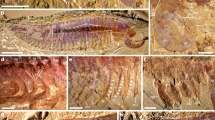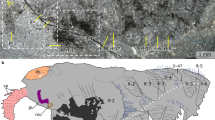Abstract
Kodymirus vagans Chlupáč and Havlíček in Sb Geol Ved Paleontol 6:7–20, 1965 is redescribed as an aglaspidid-like arthropod bearing a single pair of enlarged raptorial appendages, which are shown to be the second cephalic appendage. A number of early Palaeozoic arthropods, recognized from predominantly Cambrian Konservat-Lagerstätten, are known to have borne single pairs of large raptorial appendages. They are well established for the iconic yet problematic anomalocarids, the common megacheirans, and the ubiquitous bivalved Isoxys. Further taxa, such as fuxianhuiids and Branchiocaris, have been reported to have single pairs of specialized cephalic appendages, i.e., appendages differentiated from a largely homonomous limbs series, members of which act in metachronal motion. The homology of these raptorial appendages across these Cambrian arthropods has often been assumed, despite differences in morphology. Thus, anomalocaridids, for instance, have long multiarticulate “frontal appendages” consisting of many articles bearing an armature of paired serial spines, while megacheirans and Isoxys have short “great appendages” consisting of few articles with well-developed endites or elongate fingers. Homology of these appendages would require them to belong to the same cephalic segment. We argue based on morphological evidence that, to the contrary, the raptorial appendages of some of these taxa can be shown to belong to different cephalic segments and are the result of convergence in life habits. K. vagans is yet another important example for this, representing an instance for this morphology from a marginal marine environment.










Similar content being viewed by others
References
Bergström J (1968) Eolimulus, a Lower Cambrian xiphosurid from Sweden. Geol Fören Stockh Förh 90:489–503
Bergström J (1979) Morphology of fossil arthropods as a guide to phylogenetic relationships. In: Gupta AP (ed) Arthropod phylogeny. Van Nostrand Reinhold, New York, pp. 3–56
Bousefield EL (1995) A contribution to the natural classification or Lower and Middle Cambrian arthropods: food-gathering and feeding mechanisms. Amphipacifica 2:3–33
Briggs DEG, Collins D (1988) A Middle Cambrian chelicerate from Mount Stephen, British Columbia. Palaeontology 31:779–798
Briggs DEG, Lieberman BS, Hendricks JR, Halgedahl SL, Jarrard RD (2008) Middle Cambrian arthropods from Utah. J Paleontology 82:238–254
Bruton DL, Whittington HB (1983) Emeraldella and Leanchoilia, two arthropods from the Burgess Shale, Middle Cambrian, British Columbia. Philosophical Transactions of the Royal Society of London B. Philos Trans R Soc Lond B Biol Sci 300:553–582
Budd GE (2002) A palaeontological solution to the arthropod head problem. Nature 417:271–275
Budd GE (2008) Head structure in upper stem-group euarthropods. Palaeontology 51:561–573
Chen J-Y (2009) The sudden appearance of diverse animal body plans during the Cambrian explosion. Int J Dev Biol 53:733–751
Chen J-Y, Waloszek D, Maas A (2004) A new ‘great appendage’ arthropod from the Lower Cambrian of China and homology of chelicerate chelicerae and raptorial antero-ventral appendages. Lethaia 37:3–20
Chlupáč I (1995) Lower Cambrian arthropods from the Paseky Shale (Barrandian area, Czech Republic). J Czech Geol Soc 40:9–36
Chlupáč I, Havlíček I (1965) Kodymirus n. g., a new aglaspid merostome of the Cambrian of Bohemia. Sb Geol Věd Paleontol 6:7–20
Cisne JL (1975) Anatomy of Triarthrus and the relationships of the Trilobita. Fossils Strata 4:45–63
Conway Morris S, Caron J-B (2012) Pikaia garcilis Walcott, a stem-group chordate from the Middle Cambrian of British Columbia. Biol Rev 87:480–512
Daley AC, Bergström J (2012) The oral cone of Anomalocaris is not a classic “peytoia”. Naturwissenschaften 99:501–504
Daley AC, Budd GE (2010) New anomalocaridid appendages from the Burgess Shale, Canada. Palaeontology 53:721–738
Daley AC, Budd GE, Caron J-B, Edgecombe GD, Collins D (2009) The Burgess Shale anomalocaridid Hurdia and its significance for early euarthropod evolution. Science 323:1597–1600
Edgecombe GD (2010) Arthropod phylogeny: an overview from the perspectives of morphology, molecular data and the fossil record. Arthropod Struct Dev 39:74–87
Edgecombe GD, García-Bellido DC, Paterson JR (2011) A new leanchoiliid megacheiran arthropod from the lower Cambrian Emu Bay Shale, South Australia. Acta Palaeontol Pol 56:385–400
Edgecombe GD, Legg DA (2013) The Arthropod Fossil Record. In: Minelli A, Boxshall G, Fusco G (eds) Arthropod biology and evolution—molecules, development, morphology. Springer, Berlin, pp 393–415
Eriksson BJ, Tait NN, Budd GE, Janssen R, Akam M (2010) Head patterning and Hox gene expression in an onychophoran and its implications for the arthropod head problem. Dev Genes Evol 220:117–122
Fatka O, Konzalová M (1995) Microfossils of the Paseky Shale (Lower Cambrian, Czech Republic). J Czech Geol Soc 40:55–66
Fatka O, Kordule V, Szabad M (2004) Stratigraphical distribution of Cambrian fossils in the Příbram-Jince Basin (Barrandian area, Czech Republic). Senckenb Lethaea 84:367–381
Fatka O, Mergl M (2009) The ‘microcontinent’ Perunica: status and story 15 years after conception. In: Bassett MG (ed) Early Palaeozoic Peri-Gondwana Terranes: new insights from tectonics and biogeography, vol Special Publications 325. Geological Society, London, pp 65–101
Frase T, Richter S (2013) The fate of the onychophoran antenna. Dev Genes Evol. doi:10.1007/s00427-013-0436-x
Fu D-J, Xhang X-L, Shu D-G (2011) Soft anatomy of the Early Cambrian arthropod Isoxys curvirostratus from the Chengjiang biota of South China with a discussion on the origination of great appendages. Acta Palaeontol Pol 56:843–852
García-Bellido DC, Vannier J, Collins D (2009) Soft-part preservation in two species of the arthropod Isoxys from the middle Cambrian Burgess Shale of British Columbia, Canada. Acta Palaeontol Pol 54:699–712
Goloboff PA, Farris JS, Nixon KC (2008) TNT, a free program for phylogenetic analysis. Cladistics 24:774–786
Haug JT, Briggs DEG, Haug C (2012a) Morphology and function in the Cambrian Burgess Shale megacheiran arthropod Leanchoilia superlata and the application of a descriptive matrix. BMC Evol Biol 12(162):1–20
Haug JT, Maas A, Haug C, Waloszek D (2011) Sarotrocercus oblitus—small arthropod with great impact on the understanding of arthropod evolution? Bull Geosci 86:725–736
Haug JT, Waloszek D, Maas A, Liu Y, Haug C (2012b) Functional morphology, ontogeny and evolution of mantis shrimp-like predators in the Cambrian. Palaeontology 55:369–399
Hesselbo SP (1992) Aglaspidida (Arthropoda) from the Upper Cambrian of Wisconsin. J Paleontology 66:885–923
Holmer LE, Caron J-B (2006) A spinose stem group brachiopod with pedicle from the Middle Cambrian Burgess Shale. Acta Zool 87:273–290
Hou X, Bergström J, Ahlberg P (1995) Anomalocaris and other large animals in the Lower Cambrian Chengjiang fauna of southwest China. GFF 117:163–183
Hou X, Bergström J (1997) Arthropods of the Lower Cambrian Chengjiang Fauna, southwest China. Fossils Strata 45:1–116
Ivantsov AY, Zhuravlev AY, Leguta AV, Krassilov VA, Melnikova LM, Ushatinskaya GT (2005) Palaeoecology of the Early Cambrian Sinsk biota from the Siberian Platform. Palaeogeogr Palaeoclimatol Palaeoecol 220:69–88
Kühl G, Briggs DEG, Rust J (2009) A great appendage arthropod with a radial mouth from the Lower Devonian Hunsrück Slate, Germany. Science 323:771–773
Kukal Z (1995) The Lower Cambrian Paseky Shale: sedimentology. J Czech Geol Soc 40:67–78
Lamsdell JC (2011) The eurypterid Stoermeropterus conicus from the lower Silurian of the Pentland Hills, Scotland. Monogr Palaeontogr Soc 165(636):1–84
Lamsdell JC, Selden PA (2013) Babes in the wood—a unique window into sea scorpion ontogeny. BMC Evol Biol 13(98):1–46
Legg DA (2013) Multi-segmented arthropods from the Middle Cambrian of British Columbia (Canada). J Paleontology 87:493–501
Legg DA, Sutton MD, Edgecombe GD, Caron J-B (2012) Cambrian bivalved arthropod reveals origin of arthrodization. Proc R Soc B 279:4699–4704
Liu Y, Hou X-G, Bergström J (2007) Chengjiang arthropod Leanchoilia illecebrosa (Hou,1987) reconsidered. GFF 129:263–272
Mikuláš R (1995) Trace fossils from the Paseky Shale (Early Cambrian, Czech Republic). J Czech Geol Soc 40:37–54
Moberg JC (1892) Om en nyupptäekt fauna i block af kambrisk sandsten, insamlade af Dr N. O. Holst Geol Fören Stockh Förh 14:103–120
Ortega-Hernandez J, Legg DA, Braddy SJ (2013) The phylogeny of aglaspidid arthropods and the internal relationships within Artiopoda. Cladistics 29:15–45
Ou Q, Shu D, Mayer G (2012) Cambrian lobopodians and extant onychophorans provide new insights into early cephalization in Panarthropoda. Nat Commun 3(1261):1–17
Park LE, Gierlowski-Kordesch EH (2007) Paleozoic lake faunas: establishing aquatic life on land. Palaeogeogr Palaeoclimatol Palaeoecol 249:160–179
Paterson JR, García-Bellido DC, Yee MSY, Brock GA, Jago JB, Edgecombe GD (2011) Acute vision in the giant Cambrian predator Anomalocaris and the origin of compound eyes. Nature 480:237–240
Repina LN, Okuneva OG (1969) Cambrian arthropods of the maritime territory. Paleontological Journal 3:95–103
Resser CE (1929) New Lower and Middel Cambrian Crustacea. Proc US Natl Mus 76:1–18
Richter S, Stein M, Frase T, Szucisch NU (2013) The arthropod head. In: Minelli A, Boxshall G, Fusco G (eds) Arthropod biology and evolution—molecules, development, morphology. Springer, Berlin, pp 223–240
Scholtz G, Edgecombe GD (2005) Heads, Hox and the phylogenetic position of trilobites. In: Koenemann S, Jenner RA (eds) Crustacea and arthropod relationships (Crustacean issues 16). Taylor & Francis, Boca Raton, pp 139–165
Scholtz G, Edgecombe GD (2006) The evolution of arthropod heads: reconciling morphological, developmental and palaeontological evidence. Dev Genes Evol 216:395–415
Stein M (2010) A new arthropod from the Early Cambrian of North Greenland, with a ‘great appendage’-like antennula. Zool J Linnean Soc 158:477–500
Stein M (2013) Cephalic and appendage morphology of the Cambrian arthropod Sidneyia inexpectans Walcott, 1911. Zoologischer Anzeiger. doi:10.1016/j.jcz.2013.05.001
Stein M, Budd GE, Peel JS, Harper DAT (2013) Arthroaspis n. gen., a common element of the Sirius Passet Lagerstätte (Cambrian, North Greenland), sheds light on trilobite ancestry. BMC Evol Biol 13(99):1–34
Stein M, Peel JS, Siveter DJ, Williams M (2010) Isoxys (Arthropoda) with preserved soft anatomy from the Sirius Passet Lagerstätte, lower Cambrian of North Greenland. Lethaia 43:258–265
Stein M, Selden PA (2012) A restudy of the Burgess Shale (Cambrian) arthropod Emeraldella brocki and reassessment of its affinities. J Syst Palaeontol 10:361–383
Stein M, Waloszek D, Maas A, Haug JT, Müller KJ (2008) The stem crustacean Oelandocaris oelandica Müller re-visited. Acta Palaeontol Pol 53:461–484
Van Roy P (2006) An aglaspidid arthropod from the Upper Ordovician of Morocco with remarks on the affinities and limitations of Aglaspidida. Trans R Soc Edinburgh Earth Sci 96:327–350
Van Roy P, Briggs DEG (2011) A giant Ordovician anomalocaridid. Nature 473:510–513
Vannier J, Chen J-Y (2000) The Early Cambrian colonization of pelagic niches exemplified by Isoxys (Arthropoda). Lethaia 33:295–311
Vannier J, García-Bellido DC, Hu S-X, Chen A-L (2009) Arthropod visual predators in the early pelagic ecosystem: evidence from the Burgess Shale and Chengjiang biotas. Proc R Soc B 276:2567–2574
Waloszek D, Dunlop JA (2002) A larval sea spider (Arthropoda: Pycnogonida) from the Upper Cambrian ‘Orsten’ of Sweden, and the phylogenetic position of pycnogonids. Palaeontology 45:421–446
Waterston CD (1979) Problems of functional morphology and classification in stylonuroid eurypterids (Chelicerata, Merostomata), with observations on the Scottish Silurian Stylonuroidea. Trans R Soc Edinb 70:251–322
Walcott CD (1912) Cambrian geology and paleontology II. Middle Cambrian Branchiopoda, Malacostraca, Trilobita and Merostomata. Smithson Misc Collect 57:145–229
Whiteaves JF (1892) Description of a new genus and species of phyllocarid crustacean from the Middle Cambrian of Mount Stephen, British Columbia. Can Rec Sci 5:205–208
Whittington HB (1981) Rare arthropods from the Burgess Shale, Middle Cambrian, British Columbia. Philos Trans Roy Soc Lond B Biol Sci 292:329–357
Williams M, Siveter DJ, Peel JS (1996) Isoxys (Arthropoda) from the early Cambrian Sirius Passet Lagerstatte, North Greenland. J Paleontology 70:947–954
Wills MA (2001) How good is the fossil record of arthropods? An assessment using the stratigraphic congruence of cladograms. Geol J 36:187–210
Yang J, Ortega-Hernández J, Butterfield NJ, Zhang X-G (2013) Specialized appendages in fuxianhuiids and the head organization of early euarthropods. Nature 494:468–471
Acknowledgments
We thank Josef Pšenička (West Bohemian Museum, Pilsen), Martina Korandová (District Museum, Rokycany), and Ivana Hradská (West Bohemian Museum, Pilsen) for facilitating access to the material. Allison C. Daley (Natural History Museum, London) and Joachim Haug (University of Greifswald) provided photographs. Brigitte Schoenemann, David Legg, and two anonymous referees provided comments on the manuscript. Financial support from the Carlsberg Foundation to MS is gratefully acknowledged.
Author information
Authors and Affiliations
Corresponding author
Additional information
Communicated by: Sven Thatje
Rights and permissions
About this article
Cite this article
Lamsdell, J.C., Stein, M. & Selden, P.A. Kodymirus and the case for convergence of raptorial appendages in Cambrian arthropods. Naturwissenschaften 100, 811–825 (2013). https://doi.org/10.1007/s00114-013-1081-y
Received:
Revised:
Accepted:
Published:
Issue Date:
DOI: https://doi.org/10.1007/s00114-013-1081-y




